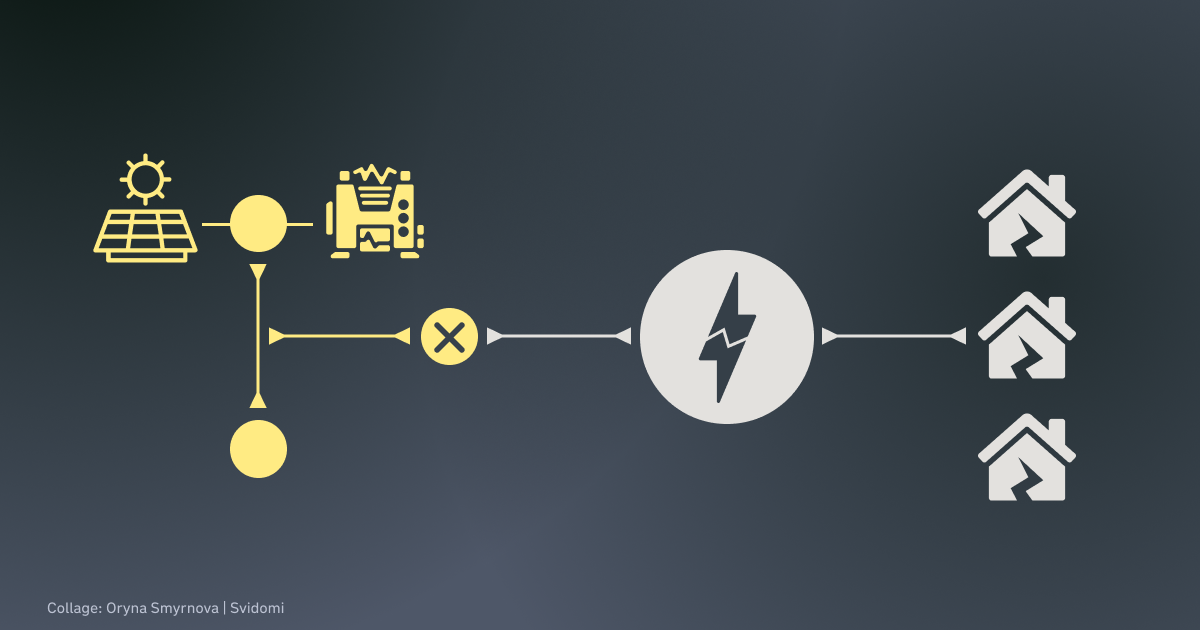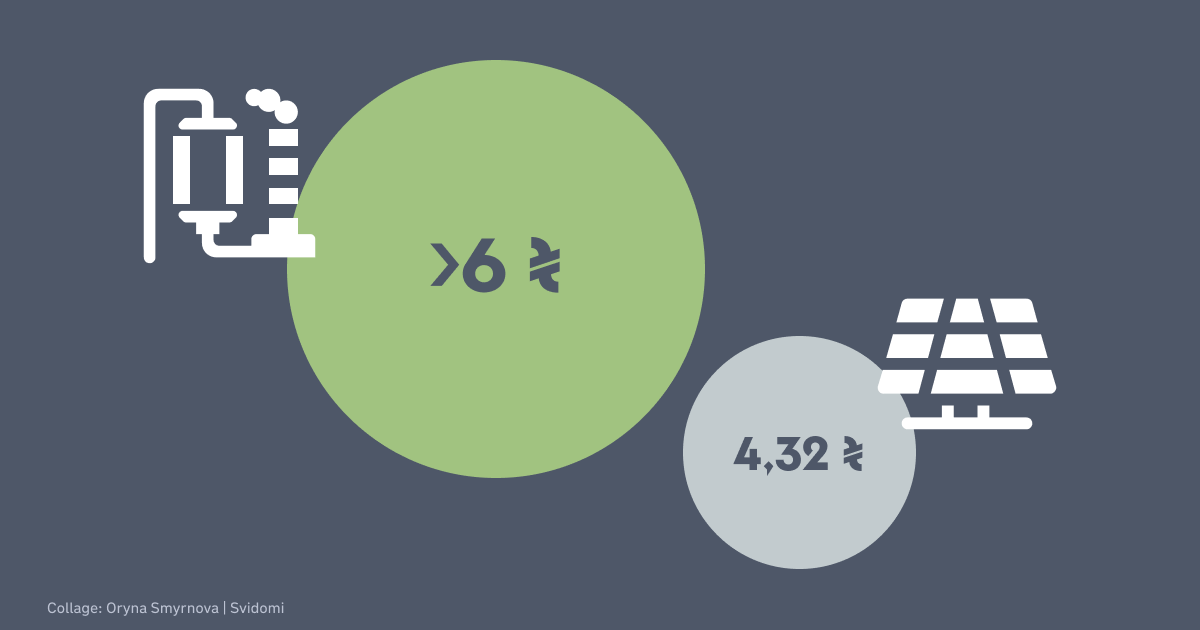Russia attacks Ukrainian power plants. How Ukraine can renew its energy sources

Russia has been targeting Ukraine's energy structure since the start of its full-scale invasion in 2022. During this time, the Russians have destroyed the Kakhovka HPP, the Trypillia and Zmiiv thermal power plants, damaged the Dnipro HPP, and more. Europe's largest nuclear power plant, Zaporizhzhia NPP, is occupied since 2022.
As a result of the massive attacks, Ukraine has imposed emergency blackouts. Ukraine also imports electricity from neighbouring countries. On May 13, Ukraine imported more than 19,000 megawatts of electricity per hour, one of the highest imports on record. In winter, Ukraine expects a power shortage of up to 35%, so Ukrainians will have electricity in their homes for 5-6 hours a day.
In the wake of the power plant strikes, Ukraine faces the difficult decision of whether to change its approach to energy supply. Svidomi discusses the alternatives to large power plants and how Ukraine can diversify its electricity production in the future.
Scenario one: The deadline is yesterday
The Russians destroyed the Zmiiv TPP with a missile strike on March 22, 2024. After the destruction, Kharkiv and the region were put on a scheduled blackout. On April 11, the Russians also destroyed the Trypillia TPP with a missile strike. It provided electricity and heat to the Kyiv, Zhytomyr and Cherkasy regions. Further Russian attacks on the distribution elements of the power grid led to scheduled blackouts across the country starting in May 2024.
Under these conditions, Ukraine is at risk of not only being without electricity in the summer but also without heating in the winter. Ukraine imports electricity from the EU. This helps to stabilise the energy system rather than avoid blackouts. Ukraine joined the shared power system in 2022. However, Ukrenergo (electricity transmission system operator in Ukraine — ed.) reports that Russia is also attacking the energy distribution infrastructure, supplying energy from Poland, Romania, Slovakia, etc. In this way, the Russians are trying to isolate Ukraine and create a situation of total blackout. Therefore, in addition to imports, the state should look for other options to solve the power supply problem.

Anna Ackermann, a climate and energy efficiency expert at the Ecoaction Centre for Environmental Initiatives, said in a comment to Svidomi that the primary solution to the decline in electricity generation is to repair thermal power plants.

"The most important decision now is to repair what can be repaired and protect what can be protected. This will not protect us from further attacks. However, we need to repair and protect what we have in order to find a way out,"
she says.
In May, the government allocated more than UAH 1.5 billion to rebuild the Trypillia and Zmiiv thermal power plants. Ukraine is also negotiating more Patriot air defence systems to protect Kharkiv and the region. President Volodymyr Zelenskyy said at a meeting with US Secretary of State Antony Blinken that the lack of air defence in Kharkiv was the reason for the massive strikes on the city and the destruction of the Zmiiv TPP.
Anna Ackermann says that during the summer of 2024, almost everyone in the country will have to develop electricity generation capabilities — from the government and local authorities to private homeowners and homeowners’ associations.

"Renewable energy (solar, wind, water — ed.) can be useful here. Since 2022, there have been several initiatives working with cities to install solar power plants. They often go hand in hand with energy storage systems for critical city infrastructure: hospitals, water utilities, schools and kindergartens. This helps to meet the basic electricity needs of these facilities,"
the analyst explains.
The government has also launched the Energodim modernisation programme for homeowners' associations. The Energy Efficiency Fund implements it in all communities across the country. Under the programme, a building's heating system can be repaired and thermal insulation installed to keep the house warm. The government covers most of the cost of the repairs.
"This is a temporary solution, but the energy sector has been waiting for this programme," says Anna Ackermann.
Scenario two: Short term
In 2024, the Ministry of Energy announced that Japan would supply Ukraine with five gas turbines to generate electricity. The ministry hailed the decision as a "step towards decentralisation" of power generation. One turbine produces about 450 megawatts of electricity per hour, and several similar turbines could meet the needs of a Ukrainian city.
According to Vasyl Novachok, deputy mayor of Khmelnytskyi, the city has 15 gas generators. They produce more than seven megawatts of electricity for the city. The generators mainly power the heating infrastructure: boiler houses and heating stations. It takes up to six months to install a gas generator. So cities like Kharkiv should start now, in time for the heating season.
Renewable energy can also be a short-term solution for municipalities in Ukraine. City authorities can raise funds or allocate funds from their budgets for residents who want to install private solar power systems for their homes. Homeowners' associations can also install solar power systems to meet the needs of their residents. Communities can also install additional community solar power plants to generate energy for a specific part of the city or a critical business. For example, in 2023, Nizhyn in the Chernihiv region began implementing a project to build a solar power plant for the local water company, where water is drawn. This may ensure water supply and distribution even during power outages.

Anna Ackermann says the only drawback of such projects is that they generate energy for their own infrastructure only.
"Nothing is put into the system. It's not established yet. But this is an important direction for the development of the electricity system, to ensure the integration of these projects as much as possible, to provide some flexibility," the analyst explains.
She also says that it is possible to develop these projects so that small plants can supply excess energy to the grid.

"This is the next step - an implemented system with hundreds of these renewable energy facilities. However, there is no single vision of how to develop such a system of small plants on a large scale in Ukraine. Firstly, there is a lack of funding for such projects, and then there is the renewal of the generation system itself,"
concludes Anna Ackermann.
In addition, small generation plants will be able to balance the system, as will distribution elements.
However, it is still unclear what will happen to heating in winter. Energy Minister Herman Halushchenko has called for preparations to be made "for a difficult winter". He also said that Ukraine had already lost eight gigawatts of power generation, so "saving electricity is important".
Svidomi contacted the Kharkiv City Council to ask about the city's preparations for the heating season. The response was that the city council and utility companies were "developing a roadmap for the installation of high-efficiency cogeneration units and block modular boiler houses" to ensure autonomous heat and hot water supply for the heating season.
In June, it was announced that Naftogaz (the largest state-owned oil and gas company in Ukraine — ed.) would transfer a gas piston unit to Kharkiv. It was completed in 2007 but has not been commissioned since.

Scenario three: Looking to the future
Although the government plans to repair damaged thermal power plants, the Ukrainian energy system needs to be transformed, particularly in terms of generation sources. As Ukraine joins the European Union, it is inevitable that it will adopt EU standards, including those in the energy sector. In 2023, the European Commission adopted a directive that requires renewable energy to account for at least 42% of all energy sources by 2030.
Ukraine is also introducing renewable energy sources. In 2022-2023, around 660 megawatts of electricity was added, mainly from solar power. According to the energy strategy, Ukraine should obtain 25% of its total generation from renewable sources by 2030. Sources include biogas plants, a combustible gas produced by burning organic waste of animal, plant and household origin. Biogas plants also produce heat.
Ukraine has a so-called "green tariff" for renewable energy. It is higher than the standard tariff. While one kilowatt per hour from a thermal power plant costs UAH 2.64 in 2024, one kilowatt from a solar power plant costs about UAH 6 per kilowatt. The government says it is trying to "support" renewable energy producers and speed up the construction of new plants.

The main problem with such a system is that the feed-in tariff incentivises large producers of renewable energy, potentially leading to a monopoly in the market. After Russia's full-scale invasion of Ukraine began in February 2022, some solar and wind power plants in the Zaporizhzhia and Donetsk regions were also occupied. As a result, producers of this type of energy are very reluctant to build new plants.
Germany has a different system. There, the government guarantees that renewable energy producers will be connected to the grid, and the feed-in tariff itself has been low — 90% of the market price per kilowatt of electricity — since the launch of a major renewable energy transition programme in the late 1990s. Germany also forced municipalities and utilities to gradually switch to buying energy from renewable sources. Tariffs have fallen over time as technology has developed.
Anna Ackermann explains that the transition to renewable energy should be gradual and sustainable. That is why it is important to preserve existing thermal power plants.

"We should try to preserve our thermal power plants. It will be much easier to replace them with alternative forms of energy production. It could be biogas, biofuels or a heat pump power plant. At the moment, we just have to look at the economy. By the end of the war, we need to plan the transition to alternative sources for thermal power plants. This is a long-term project that needs funding. So far, there are no such projects in Ukraine. So this is our energy transition, but it needs to be planned today," she says, explaining the need to develop a plan for the transition to new energy sources.
Renewable energy can also decentralise the supply of electricity and heat to consumers in Ukraine. At present, all energy is based on large thermal and nuclear power plants. Smaller plants to meet the needs of residential consumers, critical businesses and cities will diversify the country's energy production and make the system more independent and resilient to shelling.

"Solar power plants simply take up more space, and it takes a lot of rockets to hit each panel. It's a kind of "possibility" that the Russians are unlikely to be able to afford,"
Anna Ackermann says.


